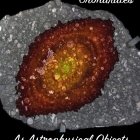“Transient Heating in the Solar Nebula – Chondrule Formation Models (Old and New)”
The parent bodies of the most primitive meteorites, the chondrites, formed ~ 4.57 billion years ago. Chondrites are remarkable for containing calcium-rich, aluminum-rich inclusions (CAIs), the oldest solids in the Solar System, whose formation has been dated to ~ 4568 Ma. Also found in abundance within all chondrites (except for CI carbonaceous chondrites) are sub-millimeter- to millimeter-sized, (mostly ferromagnesian) igneous spheres, called chondrules, from which the chondrites derive their name. The majority of chondrules formed, at most, ~ 2 million years after CAIs as melt droplets that were heated to high temperatures in transient heating events in an otherwise cold nebula. After they were heated, cooled, and crystallized, chondrules were incorporated into the parent bodies from which chondrites originate. Chondrules are capable of providing incredibly detailed information about conditions in the Solar System’s protoplanetary disk, if the process that led to their heating, melting and recrystallization could be understood. Chondrules make up to 80% of the volume of ordinary chondrites, and it is estimated that ~ 1024 g of chondrules exist in the asteroid belt today. It is believed that the asteroid belt has been depleted by a factor of ~ 1000, indicating that there may have been ~ 1027 g of chondrules in the primordial asteroid belt (at least a Mars mass of rock). Such a prevalence of chondrules suggests that chondrule-forming events were widespread in the solar nebula. A process that can melt 1027 g of rock is surely a dominant process in the solar nebula, and must be identified if early disk processes and planetary formation is to be understood. Any mechanism advanced to explain the melting of chondrules must meet the observational constraints on their formation, especially their thermal histories. In this talk, I will discuss the constraints on chondrule formation and the current state of research into formation mechanisms, as well as the attempt to understand chondrules as astrophysical objects, with implications for extrasolar protoplanetary disks.

